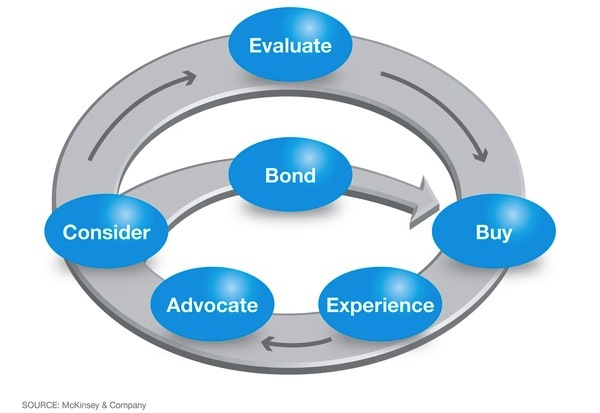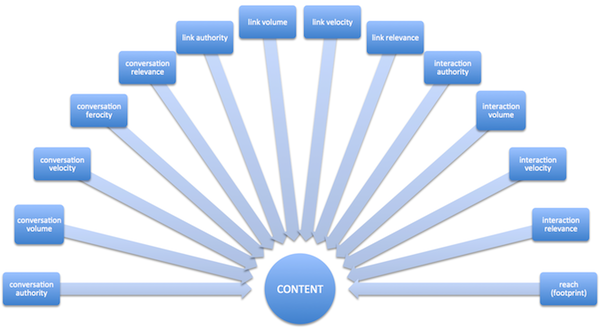
I’m not a designer, which is why Robin William’s excellent book series was my go-to resource when I started at my first design agency in 1994. The concepts of Contrast, Repetition, Alignment, and Proximity (with the unfortunate acronym) guided a lot of my creative direction and design recommendations.
Although these creative concepts can still have massive impact on site legibility, usability and comprehension, a CRAP acronym also offers SEO practitioners guidelines around a content strategy to improve website rank-ability and engagement.
Concepts & Connections
 As keyword level data has gradually disappeared, or been replaced by summarized data, SEO has needed to evolve for both planning and reporting to help justify effort and investment. Part of this evolution is looking at keyword (query) groups as concepts, aligning with user intent to help capture relevant traffic.
As keyword level data has gradually disappeared, or been replaced by summarized data, SEO has needed to evolve for both planning and reporting to help justify effort and investment. Part of this evolution is looking at keyword (query) groups as concepts, aligning with user intent to help capture relevant traffic.
This time last year I authored “Keywords are Dead! Long Live User Intent“. Many of the same research and planning is needed to support successful SEO in 2014.
Concepts help frame research around product/services aligned with distinct groups, their needs and the opportunities associated with their buying patterns, and lexicon in their purchase funnel.
An example would be in the skateboard category where the query [skateboard] might appear to be the opportune target to optimize, but potentially your audience is more interested in [skateboard accessories], a search they conduct on mobile devices.
Understanding both the intent and context of search behavior will help hone in on the key concepts that reinforce topic expertise.
Concept Development
Start with a top-level list of keywords that encompass your product, services, and differentiation – “normal” keyword query research.
I like SEMrush for discovery of competitor terms, Wordstream for breadth of expansion, UberSuggest because it’s great (and free), and the Google Keyword Planner tool that also offers great bang for the buck (at free), but it requires a Google account.
Keep the selection to a top 5-7 themes, making certain to explore your business main points of differentiation, such as target audiences, your location, awards, names of executives, etc.

The two main decision points we want to dominate in SEO are the consideration (what brands or products/services do consumers have in mind as they start their journey) and evaluation (what specific brands or products/services have they narrowed their selection down to) phases.
Omit any query you can’t definitively address (i.e., you don’t offer that service) and then hone in on those queries you’re absolutely, positively certain you can address well.
Next refine your “concept buckets” by leveraging simple tools like Google Trends (“Related searches”), beta tools like OneLook Reverse Dictionary or the excellent (free) academia concept constructor IHMC CmapTools.
Cmaps offers a downloadable app that allows you to create a concept map leveraging; existing maps, manually or via their thesaurus and/or search functions. The tool also helps to visualize the relationships between words, “join” words, and can be invaluable to content and site architecture teams in justifying CRAP content development and structure.

Relevance & Relationships
 Though concepts by themselves give us the what, creating content structures help deliver a why for both users and search engines to easily discover appropriate answers to search queries.
Though concepts by themselves give us the what, creating content structures help deliver a why for both users and search engines to easily discover appropriate answers to search queries.
Onsite relevance can be built in a number of ways by creating (or omitting) relationships between site content.
Site Structure
There’s always a lot of discussion over site architecture as it relates to ranking factors, but there’s little doubt that a well organized and structured site is better for users, so by extension is something search engines prefer. There’s some great information on best practices in site structure so I won’t dig too deep here.
Organizing your CRAP content in a distinct topic focused silo is key to engaging users and ensuring search engines can uncover deep topic expertise.
Internal Link Structure
A siloed structure is a foundation for emphasizing topical relevance, but internal linking is the glue that ties pages and like concepts together.
Moz offers a great internal linking explanation, though in the case of a CRAP content strategy, the key is to focus content silos, and mitigate “bleed” as much as feasible. Keeping like concepts connected, and diverse concepts separated, helps users and search engines stay focused, and inspires shares, engagement, and additional authority signals.
(Note: internal linking is key. External linking is also important to create connections to relevant, related and authoritative resources.)
Page Structure
The last element to ensure relevance and relationships are recognized by search engines is in the structure of the actual page itself.
In an effort to ease this recognition of concepts, page elements, and relationships, search engines are promoting schema.org as a source for webmasters to identify their content aligned with defined microdata tags:
Your web pages have an underlying meaning that people understand when they read the web pages. But search engines have a limited understanding of what is being discussed on those pages. By adding additional tags to the HTML of your web pages – tags that say, “Hey search engine, this information describes this specific movie, or place, or person, or video” – you can help search engines and other applications better understand your content and display it in a useful, relevant way.
Although the standards are constantly evolving, SEO professionals who aren’t implementing markup within their content pages are almost certainly at a disadvantage. Although a few decry the handing to search engines of data in a more easily digestible format, the key to future knowledge aggregation, categorization and display will almost certainly depend on schema or similar initiatives.
Authority & Authenticity
 Last year I spoke on a search conference panel with Maile Ohye of Google on the topic of authorship and authority. Ohye covered the Google goal of connecting authorities with topic expertise, reinforced the mantra of great content, and spoke of a “web of people”, where Google recognizes that people, and the content they create, are not created equal, and that trusted sources can gain more visibility in Google due to trust factors.
Last year I spoke on a search conference panel with Maile Ohye of Google on the topic of authorship and authority. Ohye covered the Google goal of connecting authorities with topic expertise, reinforced the mantra of great content, and spoke of a “web of people”, where Google recognizes that people, and the content they create, are not created equal, and that trusted sources can gain more visibility in Google due to trust factors.
I took the concept one step further, inferring that though “content is king”, authority content is perhaps “kingier.”
Although the phrase was created in jest, the fact that great content, when written by a recognized, visible, and connected topic expert, has the ability to rank higher, quicker, and with a more clickable search result is a function of Google’s authorship result’s snippet, their desire to be more relevant, and the Google+ social network.

One aspect of Google’s authorship that is often forgotten though, is the authentic nature of authorship.
Authority demands authenticity, a topical expertise that is genuine, broad, and consistent. An authentic person doesn’t flip flop on their subject matter; they reinforce, respond, and speak openly and passionately on their topical expertise.
Focus is a key point here. Becoming an authority on anything means being a recognized and authentic expert on one primary subject.
Although a one-topic focus might appear to be limiting, a CRAP content strategy is not, relying on the expanded opportunity of content “concepts” to provide varied content calendar that ties into an overall theme that connects subject matter expertise, to an individual, to a subject concept. (Identities to entities).
Promotion & Prominence
 If great content, written by an authority, were all you needed for a CRAP content strategy, then winning SEO would require little more than study, research, and expertise. Each of those components is key, but without inspiring visibility and conversation, CRAP content remains buried in a pile of… you get the idea.
If great content, written by an authority, were all you needed for a CRAP content strategy, then winning SEO would require little more than study, research, and expertise. Each of those components is key, but without inspiring visibility and conversation, CRAP content remains buried in a pile of… you get the idea.
Search prominence isn’t a definitive metric. The very nature of ranking algorithms is a comparative component, one site must be deemed to be more relevant to appear more prominently.
Although the definitive answer to “how does Google rank sites” is “only Google knows”, most industry folk agree SEO has moved beyond rich anchor text linking tactics since the Penguin update, and that a promotions strategy is a necessary component of content visibility, seeking to heighten the prominence in relevant venues, inspire interaction, generate chatter, and hopefully generate the signals that demonstrate rank-worthiness.
These types of signals almost certainly influence content’s ability to rank, and include:

Although links still provide a strong signal to search engines, the illustration above provides additional signals in the following categories:
- Conversations: Who, where, how fast, how aligned, how much and how “spoken” (i.e., sentiment).
- Interactions: Who, where, how fast, how aligned and how much.
- Reach: A factor of the above, the relative scale of crawlable and indexable citations that build a discoverable digital footprint on the web.
- Links: Where, how fast, how aligned and how much.
Promotions for prominence encompass content marketing, PR, partnerships, sponsorships, paid promotion, citation building, social networks, industry networks, etc. and any search engine discoverable locations on the web (this includes paid discovery services such as StumbleUpon, Outbrain, Twitter, Gravity etc. depending on audience and budgets).
Key to any CRAP content promotions strategy is variety and targeting. Although building a solid digital footprint is key to digital prominence, traffic and visibility to core audiences should be important considerations too.
Wrap the CRAP (Content Strategy)
Just as Robin William’s books inspired better design, a CRAP content strategy should inspire and drive better content definition, production, goals, search visibility and traffic.
Do you have a content strategy to share?

 As keyword level data has gradually disappeared, or been replaced by summarized data, SEO has needed to evolve for both planning and reporting to help justify effort and investment. Part of this evolution is looking at keyword (query) groups as concepts, aligning with user intent to help capture relevant traffic.
As keyword level data has gradually disappeared, or been replaced by summarized data, SEO has needed to evolve for both planning and reporting to help justify effort and investment. Part of this evolution is looking at keyword (query) groups as concepts, aligning with user intent to help capture relevant traffic.

 Though concepts by themselves give us the what, creating
Though concepts by themselves give us the what, creating  Last year I spoke on a search conference panel with Maile Ohye of Google on the topic of authorship and authority. Ohye covered the Google goal of connecting authorities with topic expertise, reinforced the mantra of great content, and spoke of a “web of people”, where Google recognizes that people, and the content they create, are not created equal, and that trusted sources can gain more visibility in Google due to trust factors.
Last year I spoke on a search conference panel with Maile Ohye of Google on the topic of authorship and authority. Ohye covered the Google goal of connecting authorities with topic expertise, reinforced the mantra of great content, and spoke of a “web of people”, where Google recognizes that people, and the content they create, are not created equal, and that trusted sources can gain more visibility in Google due to trust factors.
 If great content, written by an authority, were all you needed for a CRAP content strategy, then winning SEO would require little more than study, research, and expertise. Each of those components is key, but without inspiring visibility and conversation, CRAP content remains buried in a pile of… you get the idea.
If great content, written by an authority, were all you needed for a CRAP content strategy, then winning SEO would require little more than study, research, and expertise. Each of those components is key, but without inspiring visibility and conversation, CRAP content remains buried in a pile of… you get the idea.